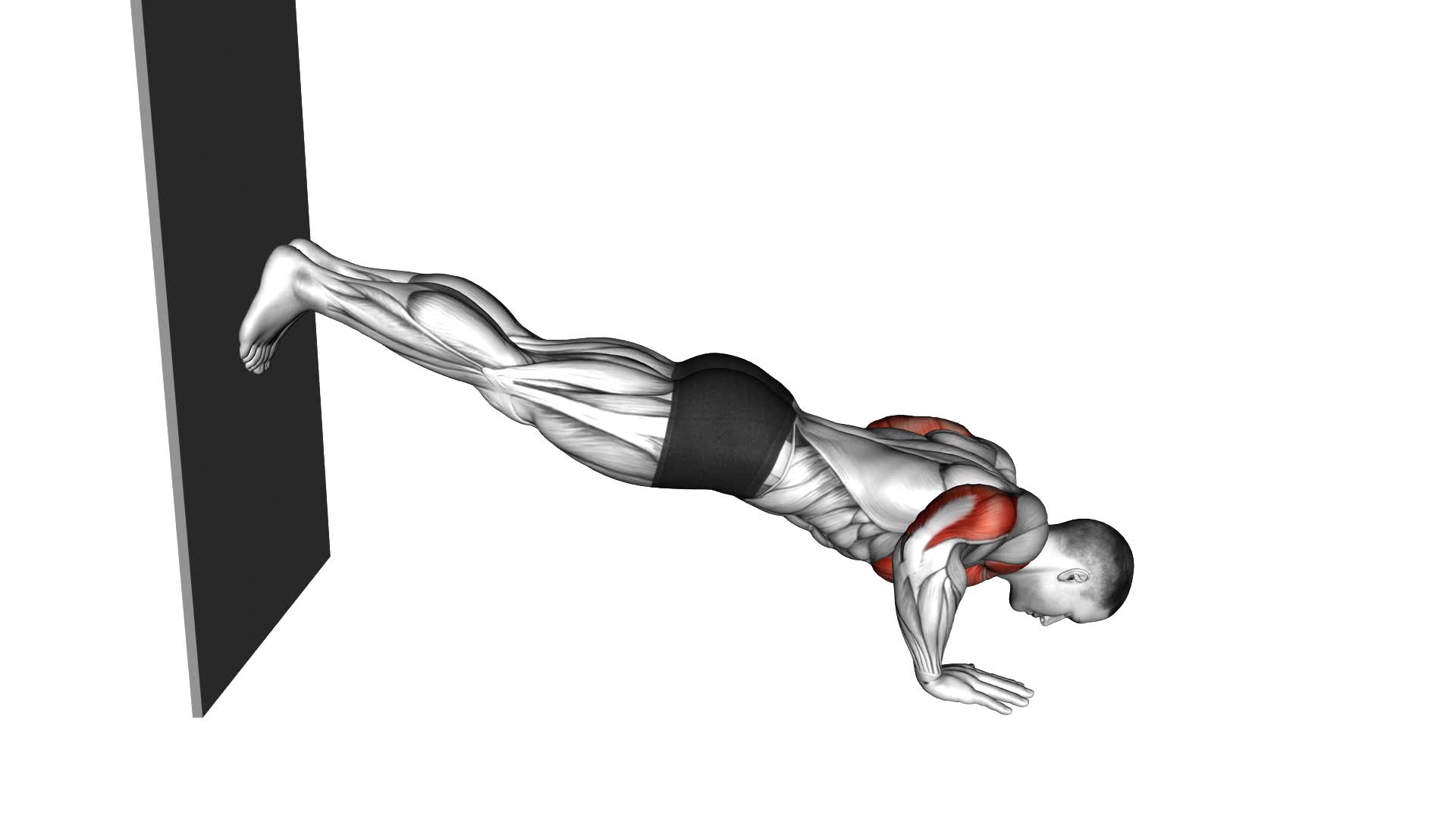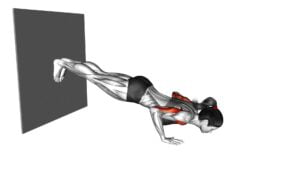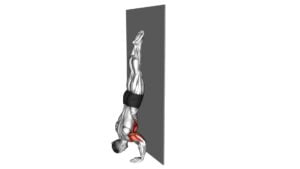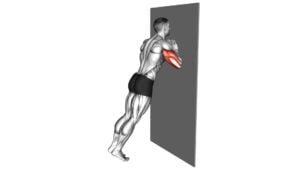Decline Push up Against Wall – Video Exercise Guide & Tips

Looking to amp up your push-up routine? Get ready to feel the burn with decline push-ups against the wall.
Watch This Exercise Video
In this video exercise guide, we'll show you the proper form and technique to maximize your results.
Discover the muscles targeted by this challenging variation and learn common mistakes to avoid.
Plus, we'll share tips and variations to take your decline push-ups to the next level.
Get ready to push yourself and see amazing results!
Key Takeaways
- Decline push-ups against the wall target upper body muscles, including chest, shoulders, and triceps.
- They increase intensity and engage muscles in a different way, leading to strength and muscle definition in the upper body.
- Decline push-ups against the wall improve core stability and balance.
- Variations and progressions of this exercise, such as using stability balls or resistance bands, can increase difficulty and provide additional benefits and challenges.
Benefits of Decline Push-ups Against the Wall
You can experience several benefits from doing decline push-ups against the wall. This exercise variation targets your upper body muscles, particularly your chest, shoulders, and triceps. By elevating your feet on a wall, you increase the intensity of the push-up and engage your muscles in a different way.
One of the main benefits of decline push-ups against the wall is that they help to build strength and muscle definition in your upper body. As you lower your body towards the ground and push back up, you're effectively working against gravity, which helps to increase muscular strength.
Additionally, this exercise can also improve your core stability and balance as you maintain a straight line from your head to your heels throughout the movement.
Furthermore, decline push-ups against the wall allow for variations in hand placement, which can target different areas of the chest and shoulders. By positioning your hands wider or narrower, you can emphasize different muscle groups, providing a more well-rounded upper body workout.
Proper Form and Technique for Decline Push-ups
To properly perform decline push-ups against the wall, maintain a straight line from your head to your heels as you lower your body towards the ground and push back up. This form ensures that you engage your core and maintain proper alignment throughout the exercise.
In addition to maintaining proper form, it's important to focus on proper breathing techniques during decline push-ups. Exhale as you push your body away from the wall and inhale as you lower your body towards the ground. This rhythmic breathing pattern helps to oxygenate your muscles and provide them with the necessary fuel for the exercise.
If you're a beginner and find decline push-ups challenging, there are modifications you can make to make the exercise more accessible. One modification is to perform the exercise on an incline instead of a decline. This reduces the amount of bodyweight you have to push up and allows you to build strength gradually. Another modification is to perform the exercise on your knees instead of your toes. This reduces the intensity of the exercise and allows you to focus on proper form and technique.
Muscles Targeted by Decline Push-ups Against the Wall
The decline push-ups against the wall primarily target the muscles in your upper body, including the chest, shoulders, and triceps. These muscles play a crucial role in pushing movements and upper body strength. By performing decline push-ups against the wall, you can effectively engage and strengthen these muscles.
Here are the muscles targeted by decline push-ups against the wall:
- Chest: The pectoralis major, also known as the chest muscles, are the primary muscles targeted during decline push-ups. These muscles help in pushing movements and contribute to a strong and well-defined chest.
- Shoulders: The deltoid muscles, located in your shoulders, are also engaged during decline push-ups. This exercise helps in developing strong and sculpted shoulders.
- Triceps: The triceps brachii, located at the back of your upper arm, are activated during decline push-ups against the wall. Strengthening your triceps is essential for overall upper body strength.
Variations and progressions of decline push-ups against the wall can further challenge your muscles and provide additional benefits. Some variations include using stability balls or resistance bands to increase the difficulty level. As you continue to improve, you can also progress to more challenging exercises such as decline push-ups on the floor or decline push-ups with feet elevated. These variations and progressions will continue to target and strengthen your upper body muscles effectively.
Common Mistakes to Avoid During Decline Push-Ups
When performing decline push-ups, it's important to avoid common mistakes that can hinder your progress.
One common mistake is letting your elbows flare out too wide, which puts unnecessary strain on your shoulders.
Another mistake is allowing your lower back to sag, which can lead to lower back pain.
Lastly, make sure you're achieving a sufficient range of motion by lowering your chest all the way down to the wall and pushing back up fully.
Elbows Too Wide
You often make the mistake of allowing your elbows to be too wide during decline push-ups. This can negatively impact your elbows alignment and compromise your shoulder stability. To ensure proper form and maximize the effectiveness of your workout, it's important to avoid this common mistake.
Here are three reasons why keeping your elbows in during decline push-ups is crucial:
- Improved shoulder stability: By keeping your elbows close to your body, you engage the muscles in your shoulders more effectively, promoting better stability and reducing the risk of injury.
- Enhanced triceps engagement: When your elbows are tucked in, you activate your triceps muscles more efficiently, leading to increased strength and muscle development.
- Reduced strain on the wrists: Wide elbows can put unnecessary strain on your wrists, leading to discomfort and potential injury. Keeping your elbows closer to your sides helps alleviate this strain and maintain proper wrist alignment.
Sagging Lower Back
To prevent sagging lower back during decline push-ups, it's important to maintain proper form by engaging your core muscles. The lower back is prone to pain and injuries if not properly supported during exercises. When performing decline push-ups, focus on keeping your back straight and your core muscles activated. This will help stabilize your spine and prevent excessive arching or sagging.
Additionally, incorporating specific strengthening exercises for the lower back, such as planks and bird dogs, can help improve the stability and strength of the muscles in that area. By strengthening your lower back, you can reduce the risk of pain and injury during decline push-ups.
Now, let's move on to the next common mistake: insufficient range of motion.
Insufficient Range of Motion
To avoid making the common mistake of insufficient range of motion during decline push-ups, it's crucial that you fully extend your arms and lower your chest close to the wall. This ensures that you're working the targeted muscles effectively and maximizing the benefits of the exercise.
Here are some tips to help you avoid this mistake and get the most out of your decline push-ups:
- Fully extend your arms: Keep your arms straight throughout the movement to engage your chest, shoulders, and triceps.
- Lower your chest close to the wall: Aim to bring your chest as close as possible to the wall without touching it. This helps to engage your chest muscles and maintain proper form.
- Modify the exercise for beginners: If you're new to decline push-ups or have limited flexibility, you can start by performing the exercise with your hands on an elevated surface, such as a bench or step. This reduces the angle and makes it easier to maintain proper range of motion.
Tips to Maximize Your Results With Decline Push-Ups
Maximize your results with decline push-ups by implementing these effective tips.
When it comes to maximizing chest strength and increasing upper body endurance, proper form is key. First, make sure your hands are shoulder-width apart and your body is in a straight line from head to toe. This will engage your chest muscles and prevent strain on your lower back.
Secondly, focus on lowering your body to the lowest point possible, without letting your hips sag or your elbows flare out. This will ensure that you're working your chest muscles to their full potential.
Additionally, try to perform each repetition slowly and with control, rather than rushing through the movement. This will increase the time under tension for your muscles and lead to greater strength gains.
Lastly, don't forget to breathe properly throughout the exercise. Inhale as you lower your body and exhale as you push back up.
Variations and Progressions for Decline Push-ups Against the Wall
How can you progress your decline push-ups against the wall?
Here are some variations and progressions to take your exercise to the next level:
- Feet Elevated Decline Push-ups: Place your feet on a stable elevated surface, such as a bench or step, while performing the decline push-ups against the wall. This increases the intensity and engages your upper body muscles even more.
- Single Leg Decline Push-ups: Lift one leg off the ground and perform the push-ups with only one leg supporting your body weight. This challenges your stability and core strength, while also targeting your chest and arms.
- Decline Pike Push-ups: Assume a pike position with your hips raised towards the ceiling and your hands on the ground. Perform the push-ups by bending your elbows and lowering your head towards the floor. This variation targets your shoulders and upper back muscles, providing a different stimulus for your upper body.
Frequently Asked Questions
How Many Calories Can I Burn by Doing Decline Push-Ups Against the Wall?
You can burn a significant number of calories by doing decline push-ups against the wall. This exercise engages multiple muscles in your upper body, including your chest, shoulders, and triceps.
The more muscles you engage, the more calories you burn. Decline push-ups against the wall also provide a challenging workout for your core muscles.
Can Decline Push-Ups Against the Wall Help in Reducing Belly Fat?
Decline push-ups against the wall can be effective for reducing belly fat. While they primarily target the upper body, they engage multiple muscle groups, including the core. By incorporating decline push-ups into a full body workout routine, you can maximize their benefits and burn more calories overall.
These exercises help to strengthen and tone your abs, ultimately aiding in fat loss. Remember to maintain proper form and gradually increase the intensity for optimal results.
Are Decline Push-Ups Against the Wall Suitable for Beginners?
Decline push-ups against the wall may not be suitable for beginners. These exercises require a certain level of upper body strength and stability. If you're a beginner, it's important to start with modified variations of push-ups, such as incline push-ups or knee push-ups. These modified variations can help build strength and gradually progress to more challenging exercises.
It's always a good idea to consult with a fitness professional who can provide proper guidance and suggest alternative exercises that are suitable for beginners.
How Often Should I Incorporate Decline Push-Ups Against the Wall Into My Workout Routine?
To determine how often to incorporate decline push-ups against the wall into your workout routine, consider your fitness goals and abilities.
It's important to maintain proper form while performing this exercise.
Start by adding it to your routine twice a week and gradually increase the frequency as you become more comfortable and stronger.
Remember to listen to your body and give yourself enough rest between sessions to avoid overtraining.
Can Decline Push-Ups Against the Wall Help in Improving Posture?
Decline push-ups against the wall can definitely help improve your posture. By targeting the muscles in your shoulders, chest, and upper back, these push-ups promote better spinal alignment and muscle balance.
This, in turn, can lead to improved posture over time. Just make sure to maintain proper form and technique to avoid injuries.
Incorporating decline push-ups into your workout routine can provide overall strength and muscle development, further enhancing your posture.
Conclusion
In conclusion, decline push-ups against the wall are a highly effective exercise for targeting multiple muscle groups, including the chest, shoulders, and triceps. By maintaining proper form and avoiding common mistakes, you can maximize your results and prevent injury.
Additionally, incorporating variations and progressions into your routine can help challenge your muscles and continue to see progress over time. Remember to consult with a fitness professional if you have any concerns or questions about performing this exercise correctly.

Author
Years ago, the spark of my life’s passion ignited in my mind the moment I stepped into the local gym for the first time. The inaugural bead of perspiration, the initial endeavor, the very first surge of endorphins, and a sense of pride that washed over me post-workout marked the beginning of my deep-seated interest in strength sports, fitness, and sports nutrition. This very curiosity blossomed rapidly into a profound fascination, propelling me to earn a Master’s degree in Physical Education from the Academy of Physical Education in Krakow, followed by a Sports Manager diploma from the Jagiellonian University. My journey of growth led me to gain more specialized qualifications, such as being a certified personal trainer with a focus on sports dietetics, a lifeguard, and an instructor for wellness and corrective gymnastics. Theoretical knowledge paired seamlessly with practical experience, reinforcing my belief that the transformation of individuals under my guidance was also a reflection of my personal growth. This belief holds true even today. Each day, I strive to push the boundaries and explore new realms. These realms gently elevate me to greater heights. The unique combination of passion for my field and the continuous quest for growth fuels my drive to break new ground.



